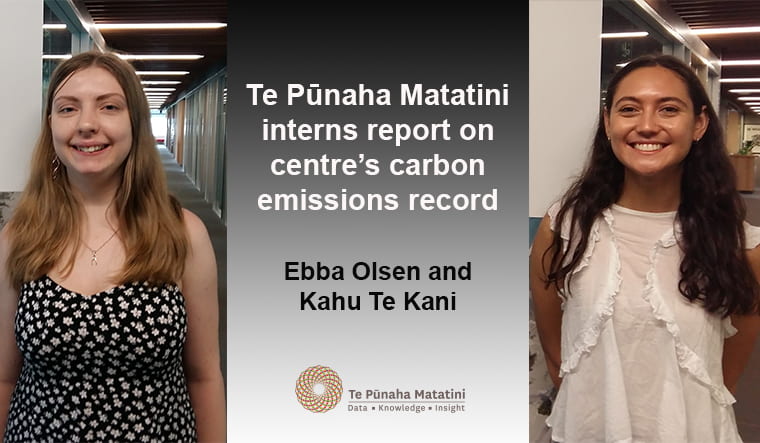By Ebba Olsen and Kahu Te Kani
Te Pūnaha Matatini (TPM) plans to introduce carbon emission reductions as a KPI from 2021 onwards. To prepare, we have analysed our carbon emissions (CO2e) from staff air travel over the past few years to better understand the centre’s past and current performance.
We calculated emissions using the Toitū carbon calculator, from all flight itineraries paid for by TPM between the years 2017 to 2019. This indicates that TPM’s air travel produced 2.04, 2.99 and 3.77 tonnes of CO2e per full-time equivalent (FTE) staff member in 2017, 2018 and 2019, respectively.
To put these numbers in perspective, our emissions were equivalent to each FTE staff member flying from Auckland to Brisbane and back twice in 2017, Auckland to Honolulu and back in 2018, and Auckland to Tokyo and back in 2019.
In 2017, TPM produced similar levels of emissions per FTE staff member compared with Victoria University of Wellington, which reported 2.00 tonnes of carbon per FTE emitted due to air travel. Yet Victoria’s emissions grew very little in 2018, sitting at 2.24 tonnes of CO2e per FTE.
TPM’s rising carbon emissions can be explained after a detailed examination of all the different reasons for staff flying (see figure below).
This analysis shows a significant increase in 2019, largely due to the “Other” category, which grew dramatically in 2019 because of the need for our investigators to attend a higher number of events related to our reapplication for TEC funding throughout the year.
As TPM is a young organisation (founded in 2015), these increases from year to year can be attributed in part to our growth, as a result of TPM attending/holding more and more events across the country. In turn, our demand for air travel as an organisation has risen, increasing our CO2 emissions.
Minimising our Annual Hui emissions
As one might expect, the largest contributing factor to total carbon emissions each year has been our Annual Hui, when the majority of our staff from around the country gather in one location. This event contributed 0.566, 0.917 and 0.748 tonnes of CO2e per FTE in 2017, 2018 and 2019, respectively.
These changes in emissions may be credited to the changes in location for the Annual Hui, as it was held in Auckland in 2017 and 2019, but was held in Christchurch in 2018.
Does this mean we should consider giving up our Hui altogether and opting for a Skype instead? Perhaps not. The Annual Hui provides an opportunity for TPM staff to come together and meet face to face, to update, discuss, and plan our research projects in a conference like manner. It is an important aspect of cultivating research excellence throughout the organisation.
Since Auckland has always been the largest hub for TPM investigators, this has meant there was an increase in the number of flights needed in 2018 compared to other years, as more investigators had to travel across the country. The distribution of our investigators as of 2019 is shown in the diagram below.
Assuming all TPM investigators attend the Annual Hui via aeroplane, we have compiled data to show the total carbon emissions produced from air travel due to this event, if it were to be held in each residing city of our investigators (see graph below).
What is quite clear is that Dunedin and Christchurch are the least efficient places to host our Annual Hui in terms of our total carbon emission measure, further reinforcing our hypothesis for such a high emissions figure for the 2018 Annual Hui.
Also in support of our theory, Hamilton and Auckland turned out to be the two lowest-carbon cities to host our Annual Hui, totalling 5.532 and 5.543 tonnes of CO2e, respectively. However, hosting in Hamilton requires 29 more investigators to travel than hosting in Auckland does, and with such a small difference between the two city’s corresponding air travel emissions, Auckland is still likely to be the most practical option.
However, we will further investigate whether Hamilton is a preferred choice for holding our Annual Hui, especially once, where feasible, other forms of transport with lower associated carbon emissions, such as train or bus, have been factored in.
It is also important to note the downsides to consistently hosting the Annual Hui and other affairs in Auckland or Hamilton, as it requires some investigators to travel far more and further than others which could result in increased absenteeism at events.
So, how can we do better?
Our analyses suggest it is important to consider holding our Annual Hui in Auckland or Hamilton. Other analyses may reveal similar insights related to other events.
As with any organisation we could lower our CO2 emissions if we simply flew less. We could hold more meetings remotely, for example over Skype, or use other more environmentally-friendly modes of transportation, if travelling is absolutely necessary. However, an obvious hurdle in using these other modes of transportation is the lack of efficient inter-city transport options across New Zealand, as highlighted in a recent article written by our director Shaun Hendy.
With the ever increasing need to address our own impacts on climate change, TPM would like to encourage other organisations to analyse their own CO2 emissions and to make improvements where possible.
Authors
Ebba Olsen is currently studying a Bachelor of Science, with a double major in Mathematics and Logic and Computation, at the University of Auckland. Ebba is excited to be able to use her analytical skills in a real world circumstance with Te Pūnaha Matatini.
Kahu Te Kani, with her passion for numbers, hopes to develop her data analysis skills during her internship with Te Pūnaha Matatini. Kahu recently completed a Bachelor of Science, majoring in mathematics and economics, at the University of Canterbury.




